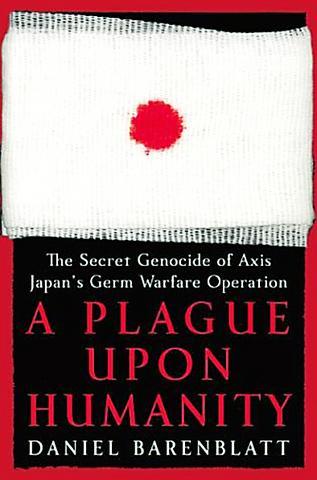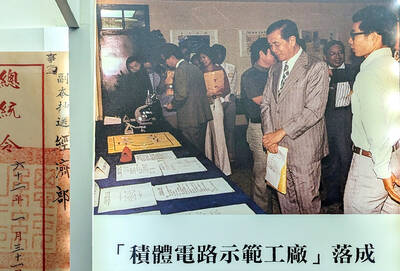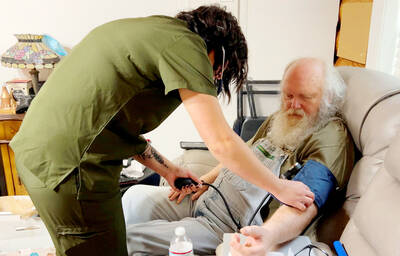A secret Japanese army unit, dubbed Unit 371, sprayed Chinese villages with bacteria, spiked their wells with disease and laced their food with germs, perhaps killing up to a million Chinese in World War II, a new book says.
"There could be over 700,000 or even 1 million" lives lost to Japan's biowarfare program, Daniel Barenblatt, author of A Plague Upon Humanity, said in a recent interview.
The book, published in the US by HarperCollins, tracks Japan's development of biological weaponry from 1931 to 1945 and its use of these weapons -- bubonic plague, typhoid, anthrax and cholera -- on civilians, many of them in China.

The biowarfare weapons were sprayed by airplanes on villages, or distributed in food, or passed through bacteria put in water wells. Some early weaponry involved dropping ceramic-shelled bombs filled with live flies and jellied cholera emulsion.
"Japan's biological warfare program in China was, as far as we know, the first use of scientifically organized germ warfare in history," said Iris Chang, author of The Rape of Nanking, the acclaimed book about the brutal Japanese occupation of the eastern Chinese city in the late 1930s.
Barenblatt says the number of lives lost to biological warfare has been difficult to determine because the victims and their families, many of whom lived in remote villages in China, did not know why they became ill after being exposed to biological weapons unleashed by the Japanese army.
"These are poor people who are for the first time telling their stories. They, at first, thought it [their illnesses] was an act of nature. Many had no idea what was happening to them," said Barenblatt.
In addition to those who died as a direct result of diseases unleashed by Japanese scientists and the military, others suffered physical disfiguration and prolonged health problems.
Many of the biological weapons were used in an attempt to sap China's resistance to the Japanese invasion during the 1930s and 1940s, according to Barenblatt's book, which tells of World War II prisoners of war from Britain, the US and Australia who were also test subjects.
According to Barenblatt, the plague bacteria released then still lingers on in some animal populations today. "As far as I know there have not been major plague outbreaks in China in recent years. [But] It is still there ... rodents still test positive for antibodies to the bubonic plague," he said.
One of the largest promoters of Japan's biological warfare efforts was Shiro Ishii, a physician with a doctorate in microbiology from Kyoto Imperial University, according to Barenblatt.
An inventor of a water-purification system, Ishii eventually involved many Japanese universities in biowar research and much of this research was spearheaded by a Japanese army biowar unit known as Unit 731.
Initially based in Harbin, in China, Unit 731's main research center was moved southeast to a more remote locale in Beiyinhe, where the village of 300 homes and shops was burned down to make room for the confidential complex.
The biowar effort -- founded with explicit approval by Japan's Emperor Hirohito, himself a trained biologist -- involved testing on civilians. The elaborate prison facilities allowed scientists to closely track the progression of disease on humans, and live dissections allowed Japanese doctors to study how certain organs were affected.
Barenblatt's book also says the Japanese military considered targeting the US with bioweapons at the end of World War II. It tells of a plan in which a plane from a specially equipped submarine would spray San Diego and saboteurs were to land secretly to poison California's water supply.
Although the US was considered a target and US servicemen were tested on by Japanese scientists, many involved with development of the biowar program were not later convicted of war crimes.
Barenblatt notes that former US General Douglas MacArthur, in charge of post-war Japan, said the research uncovered by the Japanese scientists could be useful.
"Request for exemption [from prosecution] of Unit 731 members. Information about vivisection useful," MacArthur explained in a 1947 radio message to a combined military-State Department group in Washington that supervised Japan occupation policy.
"Details from this period were suppressed during the Cold War. The US government cut a secret deal with these Japanese doctors, giving them immunity from prosecution in exchange for their medical data," said Chang in an e-mail exchange.
Said Barenblatt, "What the US did in making the deal with top doctors is unconscionable. As far as we know, no one in the US government raised any more objection to it."

Oct. 27 to Nov. 2 Over a breakfast of soymilk and fried dough costing less than NT$400, seven officials and engineers agreed on a NT$400 million plan — unaware that it would mark the beginning of Taiwan’s semiconductor empire. It was a cold February morning in 1974. Gathered at the unassuming shop were Economics minister Sun Yun-hsuan (孫運璿), director-general of Transportation and Communications Kao Yu-shu (高玉樹), Industrial Technology Research Institute (ITRI) president Wang Chao-chen (王兆振), Telecommunications Laboratories director Kang Pao-huang (康寶煌), Executive Yuan secretary-general Fei Hua (費驊), director-general of Telecommunications Fang Hsien-chi (方賢齊) and Radio Corporation of America (RCA) Laboratories director Pan
The consensus on the Chinese Nationalist Party (KMT) chair race is that Cheng Li-wun (鄭麗文) ran a populist, ideological back-to-basics campaign and soundly defeated former Taipei mayor Hau Lung-bin (郝龍斌), the candidate backed by the big institutional players. Cheng tapped into a wave of popular enthusiasm within the KMT, while the institutional players’ get-out-the-vote abilities fell flat, suggesting their power has weakened significantly. Yet, a closer look at the race paints a more complicated picture, raising questions about some analysts’ conclusions, including my own. TURNOUT Here is a surprising statistic: Turnout was 130,678, or 39.46 percent of the 331,145 eligible party

The classic warmth of a good old-fashioned izakaya beckons you in, all cozy nooks and dark wood finishes, as tables order a third round and waiters sling tapas-sized bites and assorted — sometimes unidentifiable — skewered meats. But there’s a romantic hush about this Ximending (西門町) hotspot, with cocktails savored, plating elegant and never rushed and daters and diners lit by candlelight and chandelier. Each chair is mismatched and the assorted tables appear to be the fanciest picks from a nearby flea market. A naked sewing mannequin stands in a dimly lit corner, adorned with antique mirrors and draped foliage

The older you get, and the more obsessed with your health, the more it feels as if life comes down to numbers: how many more years you can expect; your lean body mass; your percentage of visceral fat; how dense your bones are; how many kilos you can squat; how long you can deadhang; how often you still do it; your levels of LDL and HDL cholesterol; your resting heart rate; your overnight blood oxygen level; how quickly you can run; how many steps you do in a day; how many hours you sleep; how fast you are shrinking; how